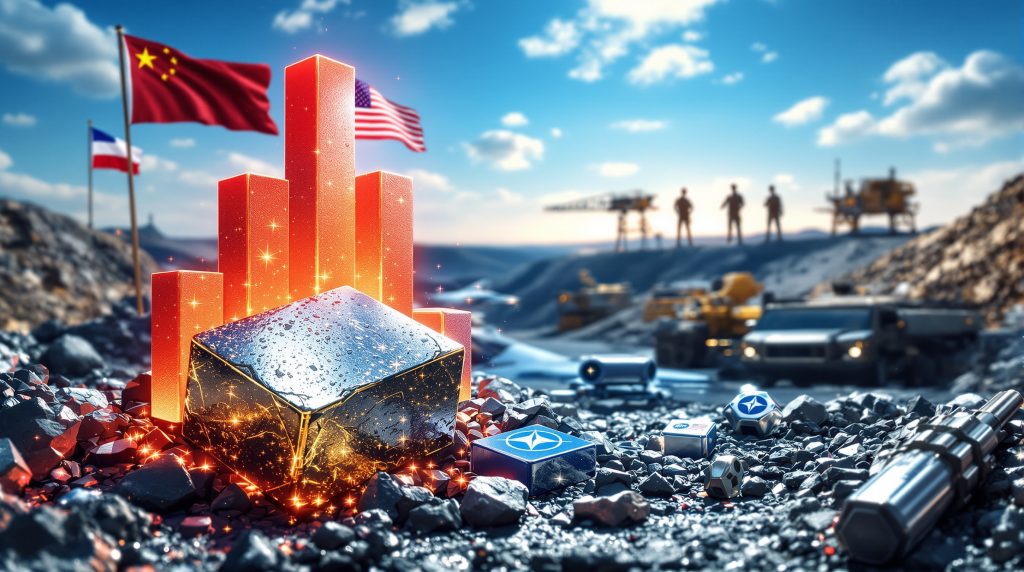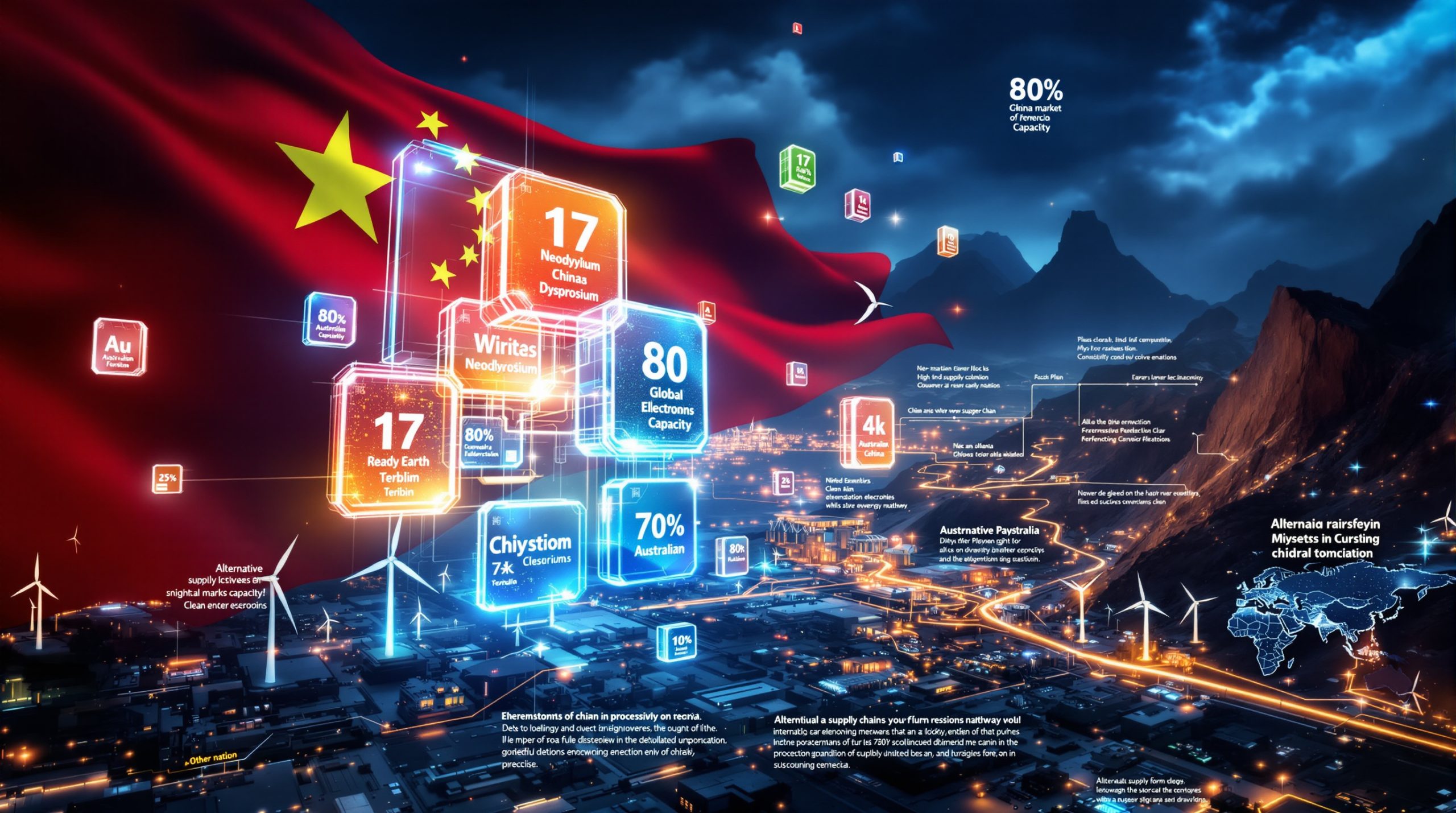Why Is Tungsten Supply Security Becoming a Critical Issue?
The global tungsten market has undergone fundamental shifts since 2022, transforming what was once a relatively stable supply chain into an area of strategic concern for Western nations. This critical metal, with its unique properties and limited production sources, has become a focal point in discussions about national security and industrial independence.
The Shifting Geopolitical Landscape
Tungsten has rapidly emerged as a strategic material whose importance extends far beyond its industrial applications. The metal's price has nearly doubled in just two years, climbing from approximately $300 per metric ton unit to $480-485 currently. This dramatic price increase reflects both growing demand and tightening supply conditions.
Defense considerations are driving much of this renewed focus on tungsten. As global tensions rise, Western nations are reassessing their mineral dependencies and identifying critical vulnerabilities in their supply chains. The recognition of tungsten as an essential defense materials strategy has accelerated efforts to secure reliable sources outside existing supply networks.
"We're witnessing unprecedented focus on critical minerals from defense departments across NATO countries. Tungsten, in particular, has moved from an industrial commodity to a strategic resource in military planning documents." – Military procurement specialist
This shift comes as Western nations increase their defense spending commitments, creating further demand pressure on already constrained tungsten supplies.
China's Dominant Market Position
Perhaps the most concerning aspect of tungsten supply security is the extraordinary concentration of production. Approximately 85% of global tungsten production is controlled by China, creating a near-monopoly situation for this critical resource. This dominant position gives China significant leverage over global supply chains.
What makes this situation particularly precarious for Western nations is the complete absence of active tungsten mining operations in North America, despite the region being the largest consumer of the metal. This disconnect between consumption and production represents a strategic vulnerability that is increasingly difficult to ignore.
Evidence suggests that tungsten availability to Western markets has been strategically managed, with export quotas and processing limitations affecting global supply. Industry analysts have observed that critical minerals strategy is increasingly being used as leverage in broader trade negotiations, adding a geopolitical dimension to what was once primarily a commercial relationship.
What Makes Tungsten Strategically Important?
Tungsten's strategic importance stems from its irreplaceable role in both defense applications and industrial processes. Understanding these critical applications helps explain why nations are increasingly focused on securing reliable supply chains.
Critical Applications in Defense and Industry
Tungsten possesses a unique combination of properties that make it indispensable for numerous high-performance applications. With the highest melting point of any metal (3,422°C/6,192°F), exceptional density (19.25 g/cm³), and remarkable hardness, tungsten serves functions that few other materials can match.
In defense applications, tungsten is essential for:
- Armor-piercing ammunition and penetrators
- Armor plating and ballistic protection
- Missile components requiring high-temperature resistance
- Aircraft counterweights and balance systems
- High-density kinetic energy projectiles
The industrial sector relies on tungsten for equally critical applications:
- High-speed cutting tools and drill bits
- Wear-resistant components in mining and construction
- High-temperature furnace components
- Electrical contacts in demanding environments
- Radiation shielding in medical and nuclear applications
The technological sector increasingly depends on tungsten for:
- Semiconductor manufacturing equipment
- Heat sinks in advanced electronics
- Specialized electrodes and electrical components
- Vibration dampening in precision instruments
Most concerning from a security perspective is the limited substitutability of tungsten. For many of its most critical applications, particularly in defense, no viable alternatives exist that can provide equivalent performance characteristics.
Western Vulnerability to Supply Disruptions
The complete absence of active tungsten mining operations in North America represents a strategic blind spot for Western nations. Despite being the largest consumer of tungsten globally, North America relies entirely on imported material, creating a fundamental vulnerability in its industrial and defense supply chains.
This dependency has increasingly caught the attention of defense establishments, who recognize the potential national security implications of supply disruptions. Military planners have begun incorporating mineral security into broader defense strategies, acknowledging that weapon systems and defense capabilities could be compromised by supply chain vulnerabilities.
Industry analysts note that reliance on a single dominant supplier for a critical material runs counter to basic supply chain resilience principles. The concentration of production in China creates a single point of failure in a system that supports critical national infrastructure and defense capabilities.
How Are Western Nations Responding to Tungsten Supply Concerns?
Faced with growing concerns about tungsten supply security, Western governments and industries are implementing multi-faceted strategies to reduce vulnerability and build resilience into critical supply chains.
Government-Level Strategic Initiatives
The U.S. government has prioritized securing alternative tungsten supply sources as part of its broader critical minerals strategy. This includes funding for domestic exploration and development projects, strategic stockpiling initiatives, and diplomatic efforts to diversify supply sources among allied nations.
The European Union has similarly implemented comprehensive critical minerals strategies that specifically identify tungsten as a priority material. These frameworks include regulatory support for European mining projects, research funding for recycling technologies, and trade initiatives designed to secure reliable supply chains.
Defense agencies have begun establishing direct relationships with potential suppliers, bypassing traditional procurement channels to ensure strategic needs are met. This direct engagement represents a significant shift in how governments approach mineral security, treating it as a defense imperative rather than simply a market issue.
Non-dilutive capital availability for strategic mineral projects has increased substantially, with government funding programs designed to accelerate domestic production capabilities. These initiatives provide financial support without the ownership dilution typically associated with traditional equity financing, making development projects more attractive to investors.
Industry Adaptation and Localization
Defense contractors have recognized the strategic risks associated with tungsten supply chain concentration and are actively seeking diversification options. This includes developing relationships with emerging Western producers, investing in recycling capabilities, and in some cases, pursuing vertical integration to secure priority access to limited supplies.
There is growing interest in Western-based tungsten projects, particularly those in politically stable jurisdictions with existing mining infrastructure. Projects in North America and Europe that previously struggled to attract investment are now receiving renewed attention as strategic considerations outweigh purely economic calculations.
Strategic partnerships between the defense sector and mining companies are becoming more common, with long-term supply agreements providing the financial stability needed to develop new production sources. These relationships often include technical support and guaranteed purchase commitments, reducing development risk.
Perhaps most significantly, there is an increasing willingness among Western buyers to pay premium prices for secure supply sources. This "security premium" reflects the growing recognition that the lowest cost option may not always be the most strategically sound choice when critical defense capabilities are at stake.
What Does the Development Timeline Look Like for New Western Tungsten Sources?
Unlike many mining projects that can take a decade or more to reach production, certain tungsten projects offer accelerated development timelines that align with urgent supply security needs.
Accelerated Pathways to Production
Brownfield tungsten projects—those with existing infrastructure and previous mining activity—offer significantly faster development timelines compared to greenfield exploration. These projects benefit from existing geological data, established access, and in many cases, remnant mineralization that can be quickly brought into production.
For projects processing wolframite, the primary tungsten ore mineral, simplified processing requirements further accelerate development timelines. Unlike complex polymetallic ores that require extensive metallurgical testing and custom processing solutions, wolframite can be concentrated using well-established gravimetric separation techniques.
Projects with existing permits have a substantial time advantage, avoiding the lengthy and unpredictable regulatory approval processes that often delay mining developments. In jurisdictions with established mining codes, these pre-permitted projects can move directly to construction and operation phases.
For the most advanced brownfield projects, production can begin within 6-9 months after securing financing, making them among the fastest path-to-production options in the mining sector. This compressed timeline allows for rapid response to emerging supply security concerns, unlike most mining industry trends that require multi-year development periods.
The capital requirements for initial tungsten production facilities are relatively modest compared to other mining operations, typically ranging from $5-7 million for a 150,000-ton processing plant. This lower capital intensity reduces financing hurdles and allows for staged development approaches that minimize initial investment requirements.
Technical and Processing Advantages
Tungsten processing, particularly for wolframite ores, benefits from relatively straightforward concentration methods based primarily on gravimetric separation. This physical separation process exploits the high density of tungsten minerals compared to waste rock, allowing for efficient concentration without complex chemical processing.
The industry standard for tungsten concentrate specifications (65% WO₃) is readily achievable using conventional processing technologies, and this standard product is accepted by smelters worldwide. This standardization simplifies marketing and reduces technical risk compared to minerals with variable or customer-specific product requirements.
Environmental impacts from tungsten processing are generally lower than many other mineral processing operations, particularly those requiring chemical leaching or high-temperature treatment. The primary environmental considerations for gravity-based concentration plants are limited to dust control, water management, and noise mitigation.
Existing infrastructure in established mining districts significantly reduces capital requirements for new tungsten projects. Access to power, water, transportation, and skilled labor forces means developers can focus investment on production facilities rather than supporting infrastructure, accelerating timelines and improving economics.
What Role Do Strategic Partnerships Play in Tungsten Supply Security?
The development of secure tungsten supply chains increasingly relies on strategic partnerships that bridge traditional industry boundaries and create new collaborative frameworks between government, industry, and security stakeholders.
Defense Sector Engagement
There is growing involvement of defense and security experts in tungsten supply chain concentration, bringing specialized knowledge of strategic vulnerabilities and national security requirements. These experts help prioritize development efforts and align commercial objectives with defense imperatives.
Direct relationships between tungsten developers and military procurement agencies are becoming more common, facilitating information sharing and creating pathways for preferential purchasing arrangements. These relationships often include technical support and qualification testing to ensure new sources meet defense specifications.
The intelligence community is providing valuable insights on supply chain vulnerabilities, helping companies and governments understand the strategic landscape and anticipate potential disruptions. This intelligence-driven approach represents a new dimension in critical mineral development.
Former government officials with defense and security backgrounds are increasingly taking roles with tungsten developers, facilitating access to strategic decision-makers and helping navigate complex government procurement systems. Their expertise helps bridge the gap between commercial mining operations and national security objectives.
International Collaboration
Cross-border partnerships are developing between allied nations, recognizing that tungsten supply security is a shared challenge that benefits from collaborative solutions. These partnerships include information sharing, joint technology development, and coordinated investment strategies.
Offtake agreements with Western smelters, such as Global Tungsten & Powders (GTP), the largest non-Chinese tungsten processor, provide critical downstream processing capacity outside Chinese control. These relationships ensure that newly produced tungsten concentrates can be processed into usable forms without relying on Chinese processing facilities.
European governments are providing supportive regulatory frameworks to encourage tungsten production within their borders, including streamlined permitting processes, research funding, and in some cases, direct financial support. These initiatives recognize the strategic importance of maintaining domestic production capabilities.
Growing coordination between NATO allies on critical mineral security has created new opportunities for multilateral approaches to tungsten supply challenges. This includes joint stockpiling initiatives, shared technology development, and coordinated diplomatic efforts with tungsten-producing nations.
What Investment Opportunities Exist in the Tungsten Supply Chain?
The strategic realignment of tungsten supply chains is creating investment opportunities across the value chain, from mining and processing to recycling and advanced manufacturing.
Emerging Western Producers
Several companies are positioning themselves to become leading Western tungsten producers outside China, leveraging existing assets and accelerated development timelines. These emerging producers offer investors exposure to the growing premium for secure tungsten supplies.
Projects in politically stable jurisdictions with established mining heritage provide lower-risk development opportunities compared to frontier regions. These operations benefit from existing infrastructure, skilled workforces, and well-established regulatory frameworks.
Scalable operations with expansion potential offer investors growth pathways beyond initial production. Projects designed with modular processing facilities that can be expanded from initial capacities (e.g., 150,000 tons) to larger operations (300,000+ tons) provide operational flexibility and capital efficiency.
Existing permits and brownfield advantages significantly reduce development risk for investors, providing greater certainty about project timelines and regulatory compliance. This regulatory clarity is particularly valuable given increasing scrutiny of new mining projects in many jurisdictions.
Financing Landscape
There is growing availability of non-dilutive government funding for strategic mineral projects, including grants, low-interest loans, and production incentives. These funding sources can significantly improve project economics while preserving equity ownership for investors.
Strategic investors, including defense contractors and industrial users, are entering the tungsten space with a focus on securing supply rather than maximizing investment returns. These investors often bring technical expertise and market access in addition to capital.
The defense sector is increasingly willing to invest directly in supply chain security through advance purchase agreements, facility funding, and joint ventures. These investments reflect the growing recognition of tungsten as a strategic material rather than simply an industrial commodity.
Increasing market awareness of tungsten supply challenges is driving broader investor interest in the sector. What was once a niche market primarily followed by specialized commodity investors is attracting attention from mainstream investment funds focused on strategic resources and defense technologies.
U.S. capital markets are becoming more accessible to strategic mineral developers, with specialized investment vehicles and growing institutional interest in critical mineral supply chains. This improved access to capital supports more rapid development of Western tungsten sources.
What Are the Environmental and Social Considerations for New Tungsten Projects?
While securing tungsten supply chains is a strategic imperative, new projects must also address environmental and social considerations to ensure sustainable development and community support.
Simplified Processing Advantages
The gravimetric separation methods used for wolframite concentration offer environmental advantages compared to more complex mineral processing technologies. These physical separation processes require fewer chemicals and generate less hazardous waste than many other mining operations.
Water consumption in gravity-based tungsten processing is typically lower than in flotation or chemical leaching operations, reducing one of the most significant environmental impacts associated with mineral processing. Closed-loop water systems can further reduce consumption in water-sensitive regions.
Waste generation from wolframite concentration is primarily comprised of inert rock material with minimal chemical alteration, simplifying waste management requirements. This reduces long-term environmental liabilities compared to operations generating acid-generating or chemically treated waste materials.
The primary environmental impacts from tungsten processing operations are typically limited to dust and noise, which can be effectively managed through standard engineering controls and operational practices. This simplified impact profile facilitates permitting and community acceptance.
Community and Regulatory Support
Brownfield tungsten development reduces new land disturbance by utilizing previously impacted areas, minimizing ecological footprints and visual impacts. This approach aligns with growing regulatory preferences for redevelopment of existing mining areas over new ground disturbance.
Operations in regions with established mining heritage benefit from community understanding of and experience with extractive industries. These communities often have realistic expectations about both the benefits and impacts of mining operations.
Local government support for strategic mineral development is increasing as the economic and national security benefits become more widely recognized. This support can facilitate permitting processes and create more predictable regulatory environments for project developers.
Employment opportunities in rural mining communities provide significant social benefits, particularly in regions that have experienced economic decline following the closure of previous mining operations. The revival of mining activities can help restore economic vitality to traditional mining regions while producing strategically important materials.
Frequently Asked Questions About Tungsten Supply Security
Why is tungsten considered a critical mineral?
Tungsten earns its critical mineral designation due to its irreplaceable role in defense applications, limited substitutability, concentrated supply chains dominated by China (85% of production), and its essential function in advanced manufacturing. With the highest melting point of any metal and exceptional hardness, tungsten remains indispensable for armor-piercing ammunition, aircraft counterweights, and high-temperature industrial applications.
How vulnerable is the Western defense industry to tungsten supply disruptions?
The Western defense sector faces significant vulnerability with no active tungsten mines in North America despite being the largest consumer. This complete production gap creates a strategic weakness, especially as geopolitical tensions rise and China demonstrates willingness to use critical minerals as leverage in US-China trade impact. Defense contractors are increasingly seeking supply diversification to mitigate these risks.
What timeline can investors expect for new tungsten projects to reach production?
Brownfield tungsten projects with existing permits can reach production within 6-9 months after securing financing, significantly faster than typical mining development timelines. The relatively simple processing requirements for wolframite ores and modest capital requirements ($5-7 million for initial production facilities) further accelerate the path to market compared to more complex mining operations.
How are tungsten prices responding to supply security concerns?
Tungsten prices have nearly doubled over the past two years, rising from approximately $300 per metric ton unit to $480-485 currently. This price increase reflects both growing demand from defense and industrial sectors and supply constraints as China reduces tungsten availability to Western markets. Market analysts anticipate continued price strength as tungsten investment trends intensify.
"The price surge we're seeing in tungsten isn't just about traditional supply and demand factors. There's a growing security premium being paid for material from reliable, geopolitically secure sources. This premium is likely to persist as supply chain resilience becomes a priority for both governments and industry."
What makes certain tungsten projects more attractive from a security perspective?
The most attractive tungsten projects from a security standpoint combine several key factors: location in politically stable, allied nations; brownfield status with existing permits and infrastructure; simple mineralogy allowing for straightforward processing; scalable operations for growing demand; and management teams with connections to defense and security establishments. These factors collectively reduce development risk while maximizing strategic value.
How does tungsten recycling factor into supply security strategies?
Tungsten recycling plays an increasing role in supply security, with approximately 30% of tungsten supply in Western nations already coming from recycled sources. The high value and relatively simple metallurgy of tungsten make it an excellent candidate for increased recycling efforts. However, even with optimized recycling, primary production remains essential to meet growing demand, particularly for defense applications requiring high-purity material.
Ready to Capitalise on the Next Major Mineral Discovery?
Stay ahead of the market with Discovery Alert's proprietary Discovery IQ model that instantly notifies investors of significant ASX mineral discoveries, transforming complex data into actionable insights. Begin your 30-day free trial today by visiting our dedicated discoveries page to understand why historic discoveries can generate substantial returns.




